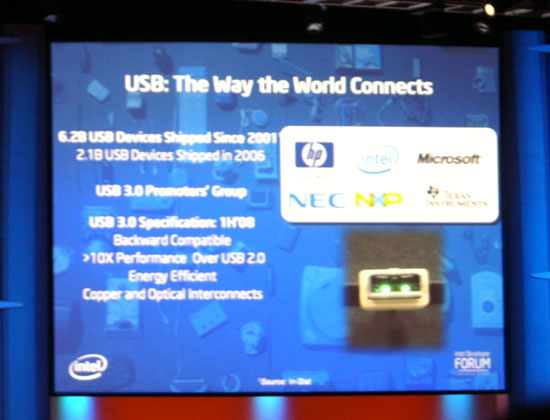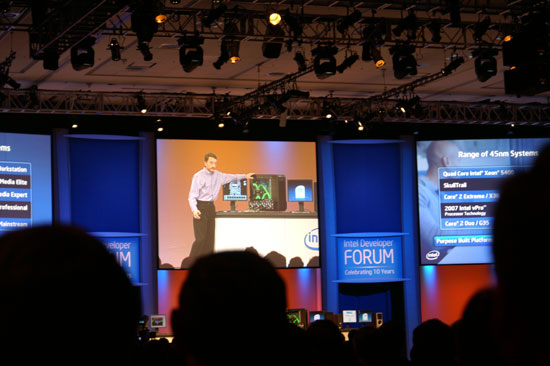Intel Developer Forum 2007 - Day 1: More Nehalem, Penryn Announced, and Gelsinger Speaks
by Anand Shimpi & Larry Barber on September 18, 2007 8:03 PM EST- Posted in
- Trade Shows
USB 3.0 and Intel's SSD
Gelsinger showed off two neat technologies during his keynote: USB 3.0 and Intel's Solid State Disk Drive.

We apologize for the blurry picture, Johan made us late to the keynote and we had to sit in the back.
USB 3.0 will have around 10x the performance of USB 2.0 (we're assuming 10x the bandwidth?) and feature both optical and copper interconnects in order to provide backwards compatibility to previous USB devices. A huge strength of USB has been continued backwards compatibility so it's good to see that USB 3.0 won't break that.

With the price of Flash memory coming down and the density going up, it's no surprise to see Intel jumping in the Solid State Drive game with its Flash. You can expect to see Intel SSDs sometime in 2008, and Intel promises to use its experience to actually offer a performance advantage over the competition; we think it's possible if Intel designs the Flash-to-SATA controller itself rather than using the same off the shelf components that everyone else is using today. Controller performance ends up dictating overall SSD performance significantly as we've seen from current generation SSDs.
SkullTrail
Pat Gelsinger also briefly showed off SkullTrail, the successor to Intel's V8 platform. We'll have more details on SkullTrail later this week, so stay tuned.

You'll remember the original announcement of SkullTrail from Intel's Beijing IDF, it's a two socket platform, designed for quad-core Penryn, with multiple x16 PCIe slots and FB-DIMM support.










8 Comments
View All Comments
GhandiInstinct - Wednesday, September 19, 2007 - link
Kurt cobain would be proud...Intel isn't getting lazy cause its on top, it's doing what a great company should do, trounce and eliminate all competition while it's customers get the cheapest and greatest technology.
GO INTEL!!!!
Now with USB3.0 even more reason to buy an ultimate rig from my AGP in 2H 2008.
DigitalFreak - Tuesday, September 18, 2007 - link
So, if it truely is 10x the performance, that would equate to 4.8Gb. Wow, who really needs ESATA then if CPU utilization is minimized? (Yes, I know ESATA will still have it's place).spinportal - Wednesday, September 19, 2007 - link
If USB 3.0 chipsets can forgo the saturation and polling deadlocking of the southbridge (data channels for SATA, IDE, USB, Ether(giga)net, PCIe bus? vs Northbridge on memory?) for competition of bandwidth, this kind of speed is worthwhile. What is the point of plugging in a USB device and lockstepping your OS's multithreading while it's negotiating? What's the point of throttling a USB channel, when your other channels tank, starve and choke?psychobriggsy - Wednesday, September 19, 2007 - link
I somehow suspect that CPU utilisation will not be minimised via "USB-offload-engines", so expect 4800Mbps USB3 to require quite a bit more CPU resources. If you want an interconnect with lower CPU utilisation, then there is always Firewire, although USB3 promises to put the freeze on that technology. Firewire needs to get its act together methinks.luxor - Tuesday, September 18, 2007 - link
Anand, these pics are blurry. You know this. We would love to be able to read some of these slides.Tristesse27 - Thursday, September 27, 2007 - link
BTW, your pictures aren't blurry because you're sitting in the back. You're pictures are blurry because you have the wrong camera for the job.rqle - Wednesday, September 19, 2007 - link
IDF is by far the most entertaining conference of them all.mattsaccount - Tuesday, September 18, 2007 - link
"Johan made us late to the keynote and we had to sit in the back."Bad Johan!